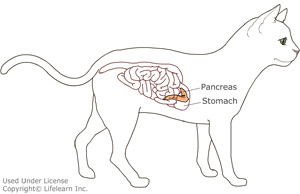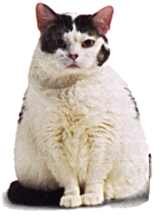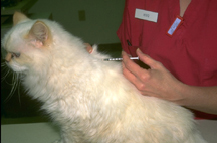What is diabetes mellitus?
Diabetes mellitus is a disease of the pancreas. This small organ located near the stomach has two different types of cells that have very different functions. One group of cells produces the enzymes necessary for proper digestion. The other group, called beta-cells, produces the hormone insulin, which regulates the level of glucose or sugar in the bloodstream and controls its delivery to the tissues of the body. In simple terms, diabetes mellitus is caused by a deficiency of insulin. The clinical signs seen in diabetes mellitus are related to the elevated concentrations of blood glucose and the inability of the body to use glucose as an energy source.
Are there different types of diabetes mellitus in cats?
Diabetes mellitus is usually classified into 2 types of disease.
Type I Diabetes Mellitus results from total or near-complete destruction of the beta-cells. This appears to be a rare type of diabetes in the cat.
Type II Diabetes Mellitus, is different because some insulin-producing cells remain. However, the amount produced is insufficient, there is a delayed response in secreting it, or the tissues of the cat’s body are relatively resistant to it. Obesity is a predisposing factor in Type II diabetes, which appears to be the most common type of diabetes in the cat.
How common is diabetes mellitus in the cat?
“Diabetes mellitus is the second most common endocrine disease in cats.”
Diabetes mellitus is the second most common endocrine disease in cats, affecting an estimated one in four hundred cats; it is seen more frequently in middle to old-age cats and is more common in males than females. While the exact incidence is unknown, the number of diabetic cats is increasing at an alarming rate due to the tremendous increase in the number of overweight and obese cats. It is important to note that a cat three pounds over its ideal weight is considered obese. That means the average domestic cat that weighs 13 pounds or more is at high risk for developing type 2 diabetes mellitus.
What are the clinical signs of diabetes mellitus?
The most common clinical signs seen in diabetic patients are an increase in water consumption and urination. Weight loss is also a common feature, and an increase in appetite may be noticed in some cats. Because of the nature of cats, these signs may go unnoticed, especially in the early stages of disease. If a cat spends a lot of time outdoors, it may drink from outside water sources such as ponds or pools of water. Cats that are fed canned or moist diets receive much of their water intake from their diet and increased water intake will be less easily recognized in these patients.
How is diabetes mellitus diagnosed?
The diagnosis of diabetes mellitus is made based on clinical signs, persistently elevated blood glucose concentration and the presence of glucose in the urine. However, a diagnosis of diabetes cannot be made on a single blood and urine sample as other conditions, in particular stress, may also cause a transient rise in glucose levels. Confirmation of diabetes may therefore require more than one blood sample collected over a period of one to five days, or a specialized test called a serum fructosamine test.
How is diabetes mellitus treated?
Diabetes mellitus is a treatable condition. Although long-term treatment requires commitment and dedication, it can be rewarding to manage this condition successfully in a beloved pet.
Initial steps in treating a diabetic cat may involve removal of any predisposing causes for the diabetes. For example, the administration of some drugs predisposes cats to develop diabetes and withdrawal of these drugs may lead to resolution of the condition. Obese cats are more prone to develop diabetes and weight reduction can lead to resolution of the signs in some cats.
All cats with diabetes mellitus benefit from being fed a well-balanced diet; many cats with this disease appear to benefit from a diet that is high in protein and low in carbohydrates. A low carbohydrate diet decreases the amount of glucose absorbed from the intestinal tract and lowers the requirement for insulin.
If there are no predisposing causes, or if correction of the predisposing causes does not lead to resolution of the diabetes, specific treatment is required. Although a small proportion of cats will respond to oral hypoglycemic medication, most cats will require insulin injections to control the diabetes.
During the initial stages of treatment, you will need to test your cat’s urine frequently until an appropriate insulin dosage is determined. Most cats will achieve initial stabilization within a few days to a few weeks, and will require twice daily injections of a small dose of insulin. Very small needles are available which cause no pain to the cat, and within a short time the procedure becomes routine. Your veterinarian will determine the appropriate administration times, dosages and type of insulin that your cat requires.
Do treated cats need to be monitored?
Yes, it is important to monitor treatment to make sure it is working properly, and to determine if any adjustments to the insulin dosage are necessary. Part of the treatment monitoring will be by periodic blood samples collected by your veterinarian.
To assist in the care of your cat, it is particularly valuable to keep accurate records of the following information:
Daily records:
- Time of insulin injection
- Amount of insulin injected
- Amount and time of food fed and eaten
- Amount of water drunk
Weekly record:
- Weight of the cat
“You should never change the dose of insulin without first discussing it with your veterinarian.”
In addition to these records, it can be valuable to monitor the quantity of glucose passed in the urine as a guide to the effectiveness of the treatment. This is best done on urine that is passed during the night or first thing in the morning. To collect urine, it is usually easiest to replace the normal cat litter with specially designed urine collecting pellets or clean and washed aquarium gravel overnight. These materials will not soak up any urine, which can then be collected into a clean container for testing. Your veterinarian may test the urine or they may supply you with a kit to test it yourself. If there is a marked change in the amount of glucose in the urine, this may indicate the need to alter the insulin dose, but you should never change the dose of insulin without first discussing it with your veterinarian. Changes in the insulin dose are usually based on trends in urine glucose concentrations, as there is normally some day-to-day variation.
What happens if my cat receives too much insulin?
“If a cat receives too much insulin, it is possible for the blood sugar level to drop dangerously low.”
If a cat receives too much insulin, it is possible for the blood sugar level to drop dangerously low. For this reason, it is important to be very careful in ensuring the cat receives the correct dose of insulin.
The typical signs displayed by a cat with a very low blood sugar level are weakness and lethargy, shaking, unsteadiness and even convulsions. If a diabetic cat shows any of these signs it is important to seek immediate veterinary advice or attention. In mild cases of hypoglycemia, you may observe “wobbling” or “drunken” walk or appearance and the cat may not arouse when you call or pet them. In cases of mild or early hypoglycemia, you should administer approximately a tablespoon of corn syrup, honey or sugar solution by mouth. If your cat is showing more severe signs such as ataxia or severe incoordination and unsteadiness during walking, or convulsions, you should seek immediate veterinary care. Your veterinarian can advise you on specific emergency treatment of low blood sugar in your cat.
© Copyright 2009 Lifelearn Inc. Used and/or modified with permission under license.




